This post may contain affiliate links. Please read our disclosure policy.
How to cook eggplant in the oven or Air Fryer! Bake, broil, or Air Fry eggplant (aka aubergine) whole, halved or sliced/cubed to perfection every time. Top tips including how long to bake eggplant depending on its size and cooking method!
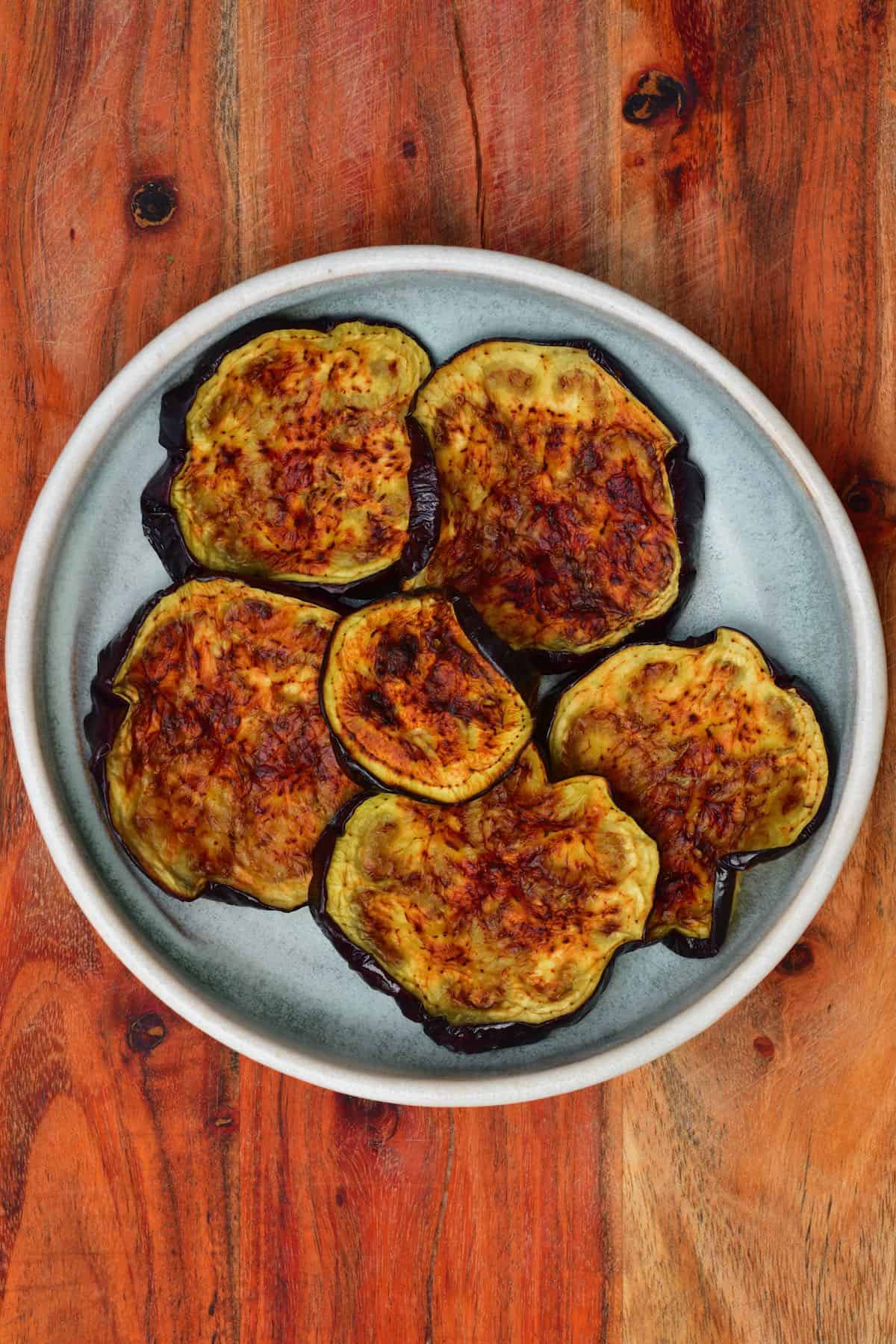
I’m no stranger to eggplant recipes, so it’s pretty shocking I haven’t shared my simple methods on baked eggplant and Air Fryer eggplant previously. This post will take you through how to cook eggplant in the oven and an Air fryer – from whole, halved, or sliced – so you never get it wrong!
Once baked, you can enjoy the aubergine as-is or use it within recipes like this Eggplant and Halloumi Wrap, baba ganoush, and miso-glazed eggplant. It will also work within lasagna, turned into eggplant parmesan, and for moussaka – the list goes on and on! Sometimes I’ll serve baked eggplant slices as-is, with a bit of marinara sauce! Yum!
The truth is, eggplant has a bit of a bad reputation for being bland yet also bitter, with an odd texture if not baked to perfection. However, these days eggplant is bred to remove most of the bitterness. And when seasoned well, it is anything but bland. And with the correct method on how to roast eggplant slices, cubes, halves, whole, etc., and you’ll never have to deal with that “underbaked” texture again.

All you need is to follow a few tips and a simple process!
Want to save this recipe?
How To Pick A Good Eggplant
The first step to getting things “right” is picking a good eggplant. These days with increased home delivery, this might be a bit tricky, but here are a few things to look out for when selecting eggplant in person.
Choose one with glossy, smooth skin. Depending on where you’re based, the color of the eggplant can vary, but in the UK, choosing an eggplant that is a vivid dark purple with taut, shiny skin is essential. Dull or wrinkled skin can both be signs of bad quality and potential bitterness.
It’s equally important to look out for a green stem (not brown/dried), which can indicate ripeness (eggplants tend to become bitter as they age, so the fresher, the better).
When pressing the eggplant, it should feel firm, with a slight give. If it’s too soft, then the eggplant is likely overripe and old.
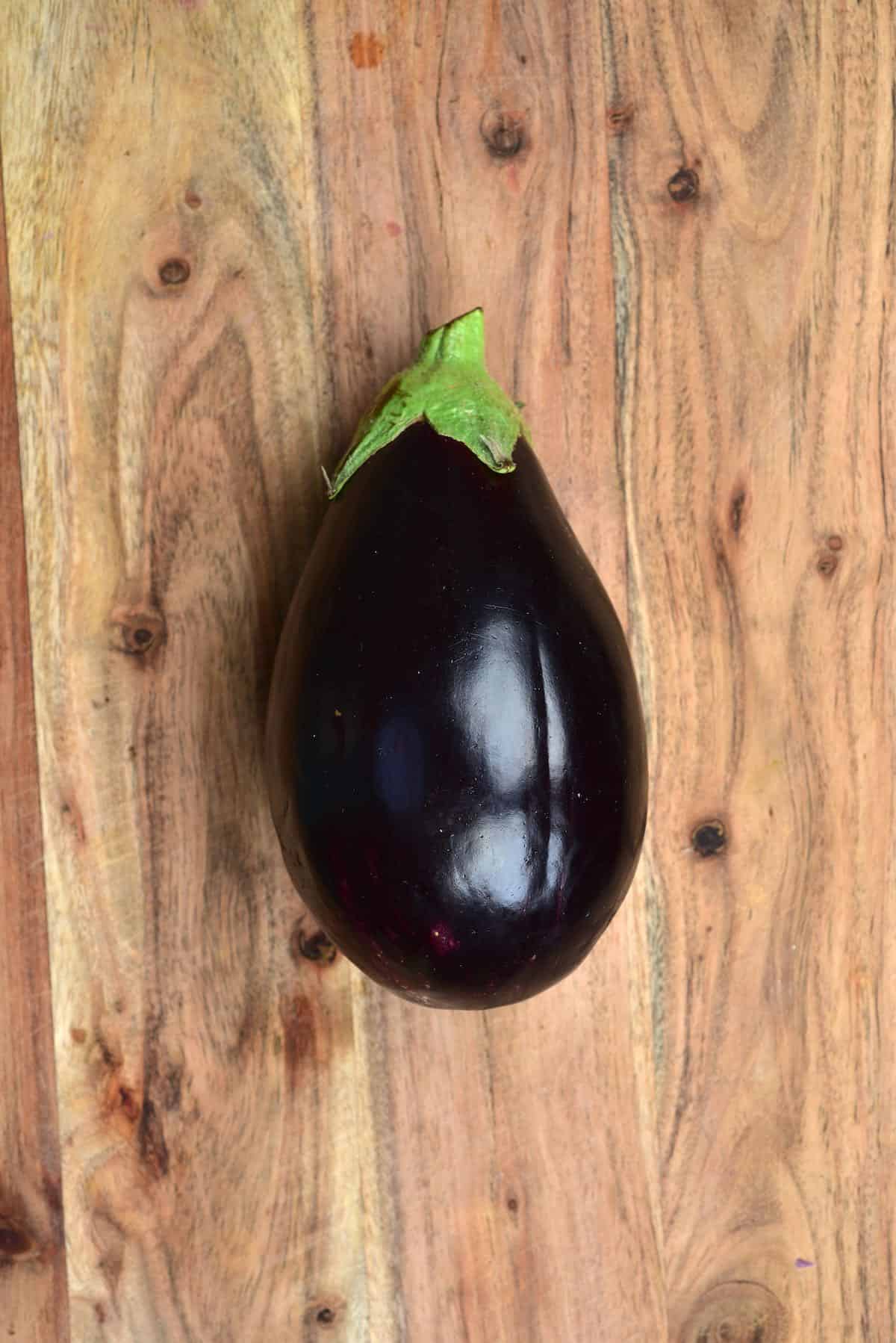
The size of the eggplant also matters. If you want one with fewer seeds (thus less likely to be bitter as the seeds are where the bitterness comes from), you may prefer to use multiple smaller eggplants than the one extra-large eggplant.
Top Tip: A lot of the bitterness comes down to the aging of the eggplant. For that reason, it’s best to eat your eggplant as soon as possible (within five days) after buying. Alternatively, you can follow the baked or air-fried eggplant methods below then store them in the freezer for longer-term storage!
How To Cook Eggplants
Salting Eggplant – Optional
The first step I sometimes do when cooking eggplant is to “salt” it to help extract bitterness from the eggplant and drain excess liquid – thus providing better texture!
First, slice the eggplant in half, into 1/2-inch coins (os sliced lengthwise across the eggplant for 1/2-inch “steaks”), or cubed into 1-inch slices (it doesn’t have to be super exact, but close enough – otherwise, the cooking times will vary).
Tip: If you’re baking the eggplant halved, then I like to slice diagonal lines (like a grid) across it to help the salt permeate a little deeper and draw out the moisture.
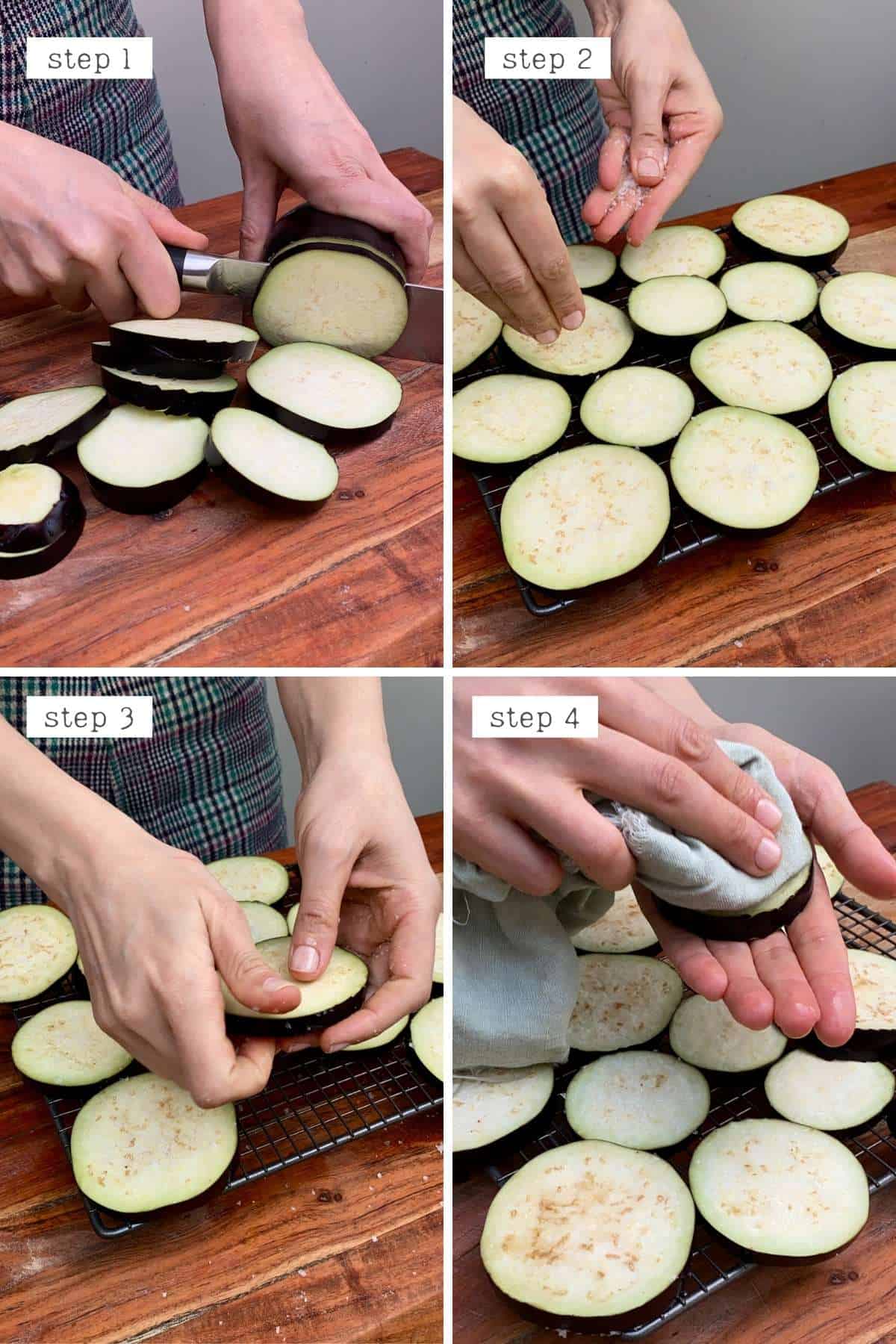
Depending on how you’ve sliced the eggplant (halved, sliced, or cubed), you can drain it on a tray over kitchen paper towels, on a wire rack, or within a colander (in the sink or draining into a bowl/dish).
Liberally salt the eggplant on all sides where the flesh is present and allow to sit for 30 minutes. During this time, it will “sweat” out excess liquid.
Once rested, pat away the excess moisture (and salt) with paper towels. If they’re sliced in half, I like to gently squeeze the eggplant over the sink to get rid of the most liquid possible.
Optionally, you can rinse them too (then dry thoroughly), but I usually skip that step.
How To Roast Eggplant In The Oven
How to Roast Eggplant Slices/Cubes and halved
After slicing and salting the eggplant, toss it with a bit of oil (for cubes) or brush with oil (for sliced or halved), lay out the slices/cubes on a baking tray. If using halved eggplant, then lay it flesh-side downwards.
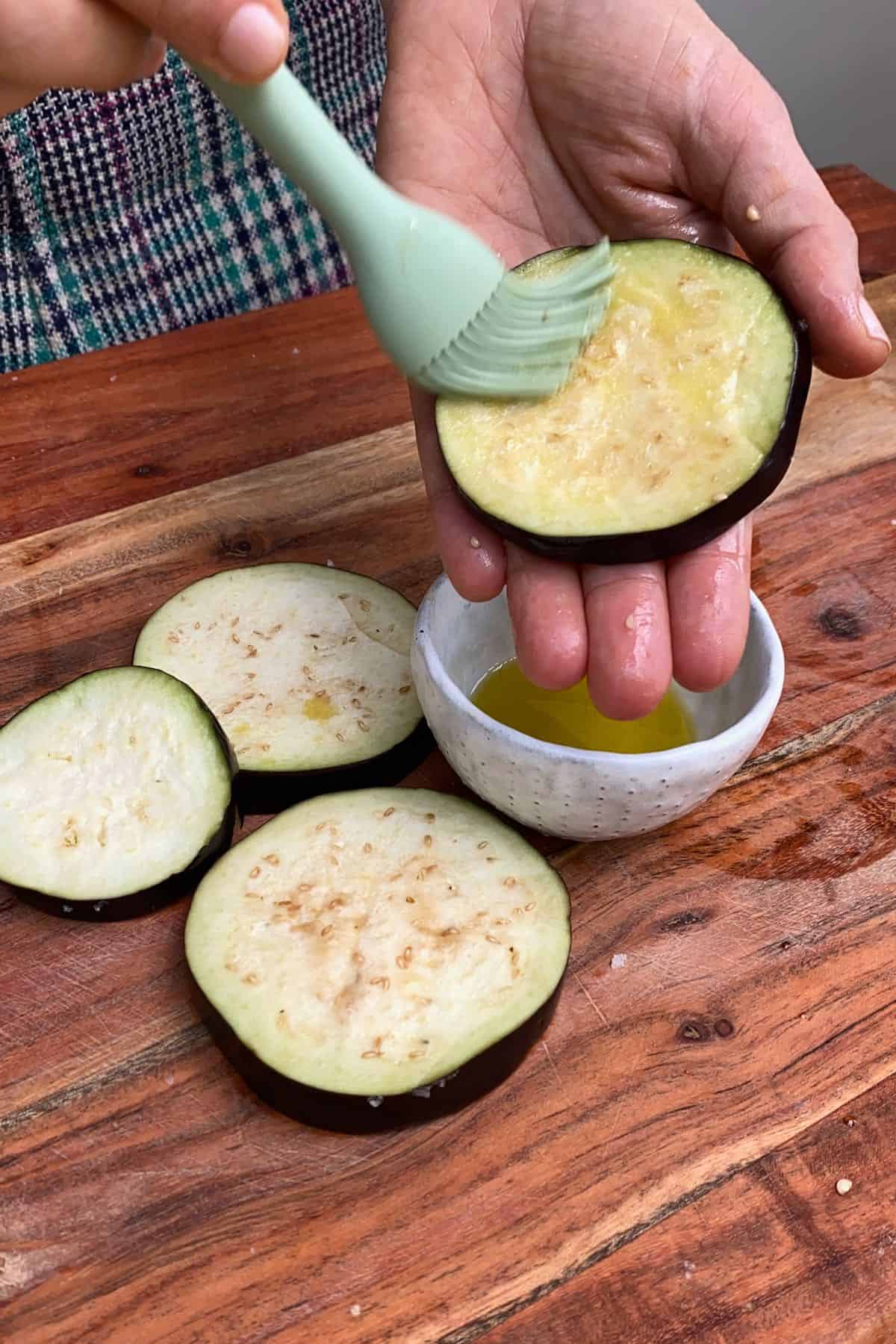
Roast in a preheated oven at 400ºF/200ºC for between 25-32 minutes, flipping halfway through (for the coins and cubes). Or for 35-40 minutes, not flipping – if roasting halved eggplants. This will vary based on individual ovens, so check at the shortest time and increase as needed.
When ready, the baked eggplant should be a golden brown color with a tender custardy middle. For the halved eggplant, the skin will look puckered and slightly collapsed.

How To Roast Eggplant Whole
This method is excellent for when you want a super velvety, custardy eggplant for dips and spreads. Baked whole eggplant means no chance of the eggplant crisping up.
Prick the eggplant just a few times all over, then transfer it to a baking tray. Roast the eggplant until the skin gets wrinkly and begins to collapse – which means the flesh inside has become lovely and tender – usually between 45-60 minutes.
You can check the tenderness with a knife, too – it should slide through the baked whole eggplant with little resistance.
Make sure not to forget to poke holes in the eggplant; otherwise, the steam can build up inside of them and lead to a messy situation in the oven or across your entire kitchen.
BONUS Method: Broiled Eggplant (Grilled Eggplant)
If I’ve cut my eggplant into coins, I’ll often use the oven grill/broiler to cut down on the cooking time.
Place the salted/rested and oiled slices in a single layer on a baking tray and broil for between 4-6 minutes per side until golden brown and tender in the middle.
Air Fryer Eggplant
Lay the eggplant slices out in a single layer, with space in between the pieces. Air fry in a preheated Air Fryer at 400ºF/200ºC for around 20 minutes, flipping once halfway (for slices) or between 15-20 minutes for cubed pieces.
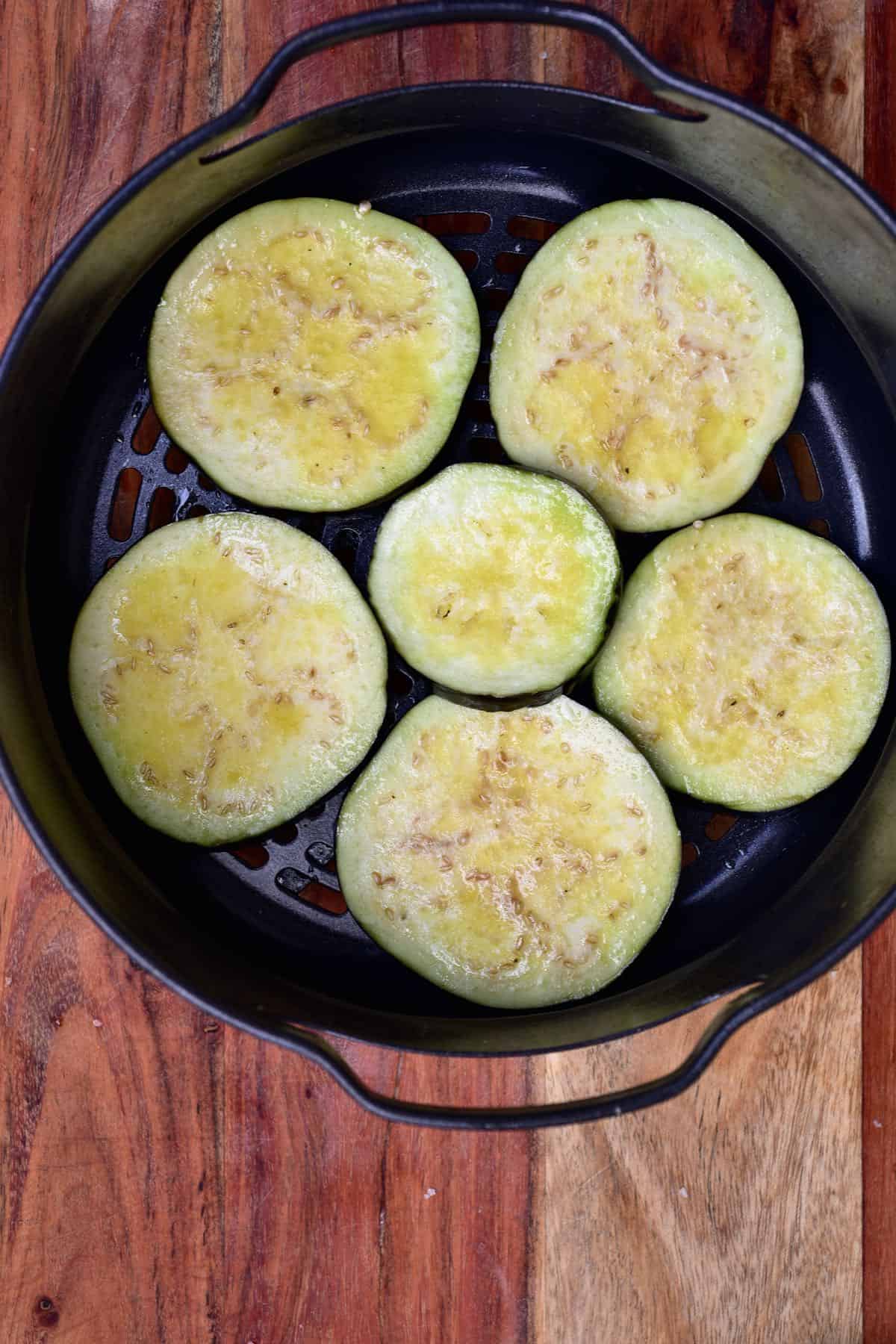
Cook the slices/cubes in batches but don’t worry about the first batch going cold. Once all of the batched are ready, place them all back in the Air Fryer (no space in-between required!). Air fry for just a few minutes (3-4 or so) to warm them all up at 400ºF/200ºC.
When ready, season and serve!

How To Store
Store: the leftover baked eggplant (and the air fryer eggplant) will store within an airtight container in the refrigerator for up to 5 days.
Freeze: to freeze the eggplant, lay the pieces in a single layer on a tray, and freeze until solid. Then transfer to a freezer-safe bag or container for up to 12 months.
For the halved/whole eggplant, you can blend the flesh into a smooth eggplant puree. Freeze within a larger freezer-safe container/bag (with at least 1-inch headspace for expansion). Alternatively, portion into an ice-cube tray/silicone mold. That way, you can remove exactly how much is needed each time.
Use/Reheat: you can allow the frozen eggplant to thaw before using. Alternatively, if using within pan-fried dishes/soups/stews, throw the slices/cubes in from frozen.
To reheat, place the eggplant back in the oven or air fryer until warmed through. This usually takes about 10 minutes (or longer when reheating from frozen).

Top Tips and FAQs
- Don’t forget to flip the eggplant – otherwise, it won’t crisp up as much and may go “limp” in the oven!
- It’s not always necessary to salt the eggplant – especially if you pick smaller ones as they are bred today to have less bitterness.
- Eggplant is absorbant – so don’t worry if your oil seems to disappear as soon as you add it. Make sure to oil them well for the best texture without being greasy.
- The thinner you slice the eggplant, the less time they’ll need baking, and the more caramelized the edges will be. Just be careful as, too thin, and they’ll likely burn.
- Do you have to peel eggplant? No- you don’t. Not only is the skin edible, but it also helps hold the eggplant slices together once cooked. It’s only when using it for dips that you’ll scoop out the flesh and leave the skin behind (after baking, though!)
- You can season the eggplant 101 different ways, so feel free to experiment! It’s best to leave the seasoning till post-baking, though, for best results.
- For softer slices of eggplant, feel free to space them closer together on the baking tray and skip flipping them. However, if you want crispier slices, then leave room for the air to circulate and make sure to flip them.
Recipes Using Eggplant
Not only can you use the baked eggplant slices/cubes within pasta dishes, stir-fries, stews, buddha bowl (like this Mediterranean salad with grains), curries (like this Thai red curry), and more – but here are some of my other eggplant recipes for inspiration.
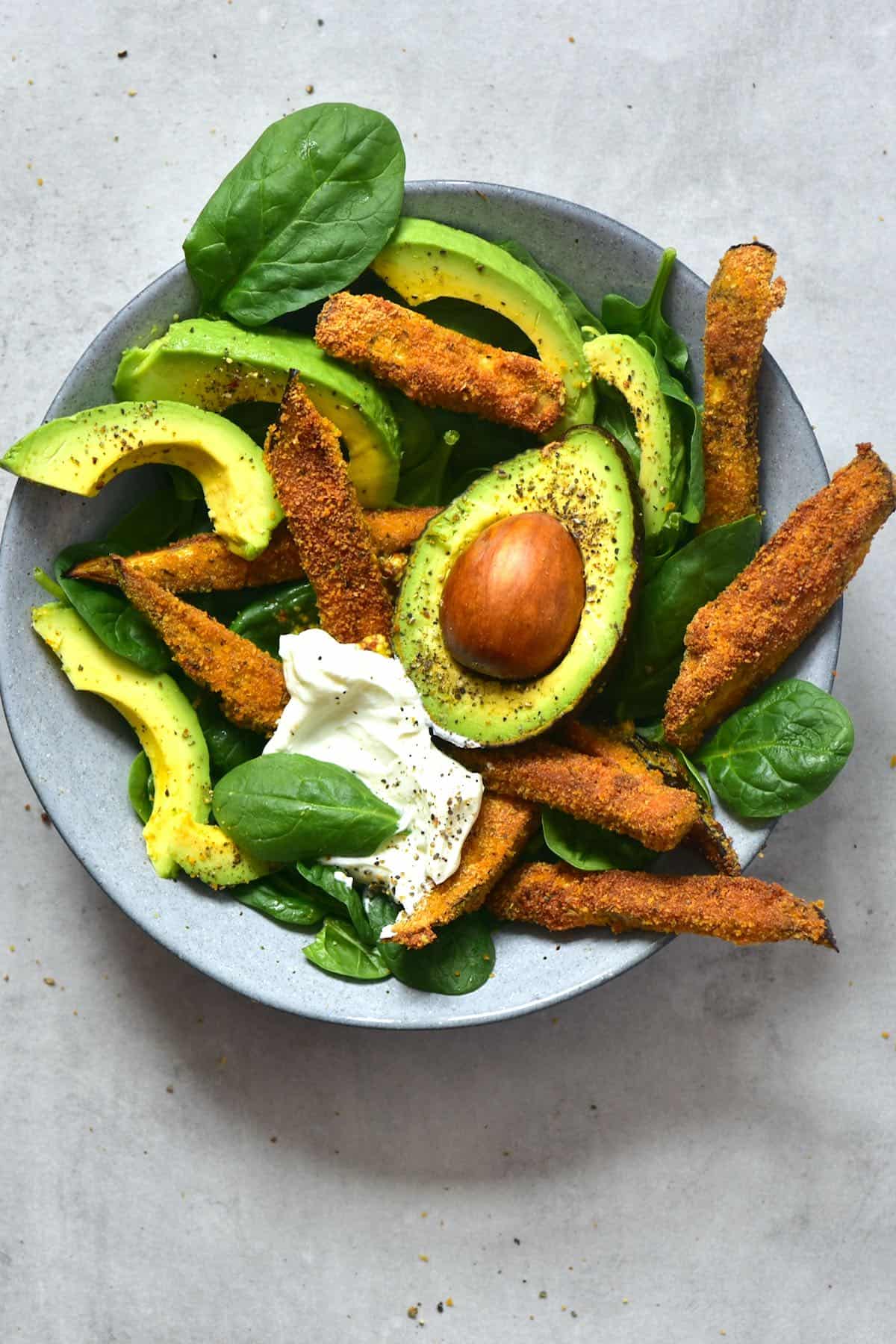
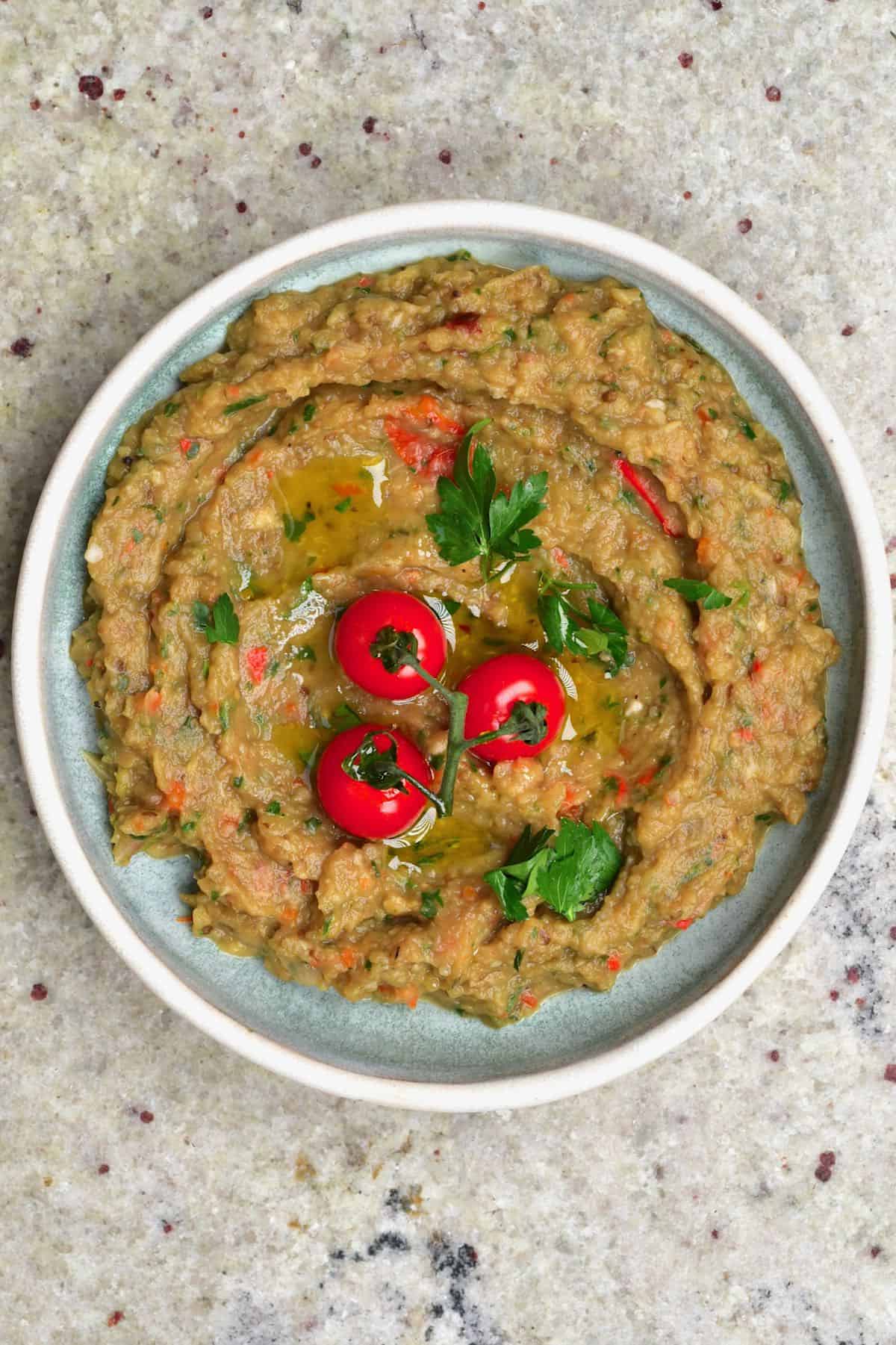
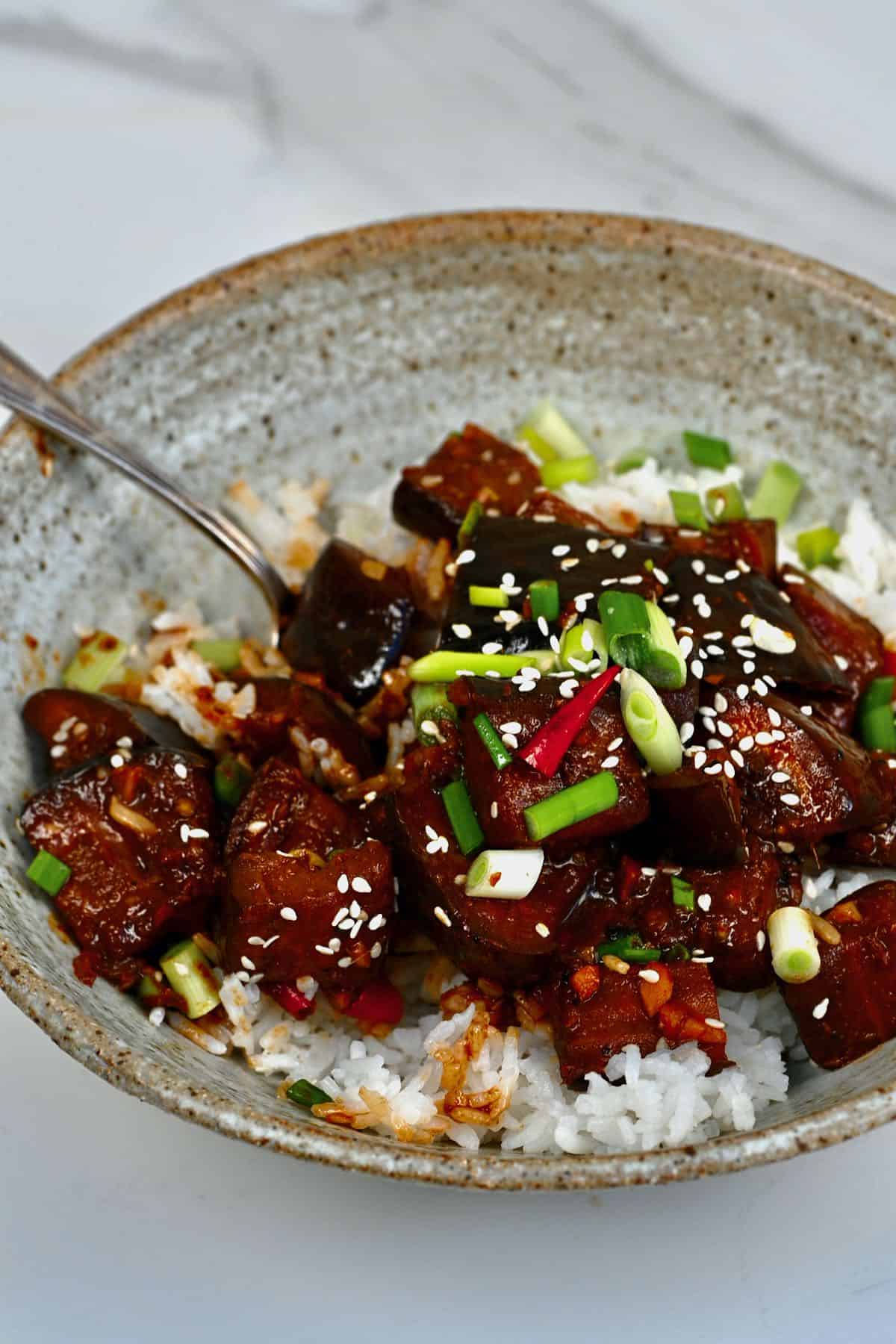
If you try any of these ways to cook eggplant, I’d love to hear your thoughts/questions below. Also, I’d appreciate a recipe card rating below, and feel free to tag me in your recipe recreations on Instagram @Alphafoodie!
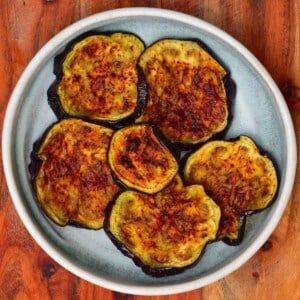
How To Cook Eggplant (Baked, Broiled & Air Fryer Eggplant)
Equipment
- Air fryer optional
Ingredients
- 1 eggplant
- 1 Tbsp olive oil
Instructions
How to Roast Eggplant Slices/Cubes and halved
- After slicing and salting the eggplant, toss it with a bit of oil (cubes) or brush with oil (sliced or halved), lay out the slices/cubes on a baking tray. If using halved eggplant, then lay it flesh-side downwards.
- Roast in a preheated oven at 400ºF/200ºC for between 25-32 minutes, flipping halfway through (for the coins and cubes). Or for 35-40 minutes, not flipping – if roasting halved eggplants. This will vary based on individual ovens, so check at the shortest time and increase as needed.When ready, the baked eggplant should be a golden brown color with a tender middle. For the halved eggplant, the skin will look puckered and slightly collapsed, with a custardy middle.
How To Roast Eggplant Whole
- This method is excellent for when you want a super velvety, custardy eggplant for dips and spreads. Baked whole eggplant means no chance of the eggplant crisping up.Prick the eggplant just a few times all over, then transfer it to a baking tray. Roast the eggplant in a preheated oven at 400ºF/200ºC until the skin gets wrinkly and begins to collapse – which means the flesh inside has become lovely and tender – usually between 45-60 minutes.You can check the tenderness with a knife, too – it should slide through the baked whole eggplant with little resistance.Make sure not to forget to poke holes in the eggplant; otherwise, the steam can build up inside of them and lead to a messy exploding eggplant situation in the oven or across your entire kitchen.
Broiled Eggplant (Grilled Eggplant)
- If I've cut my eggplant into coins, I'll often use the oven grill/broiler to cut down on the cooking time.Place the salted/rested and oiled slices in a single layer on a baking tray and broil for between 4-6 minutes per side until golden brown and tender in the middle.
Air Fryer Eggplant
- Lay the eggplant slices out in a single layer, with space in between the pieces. Air fry in a preheated Air Fryer at 400ºF/200ºC for around 20 minutes, flipping once halfway (for slices) or between 15-20 minutes for cubed pieces.
- Cook the slices/cubes in batches but don't worry about the first batch going cold. Once all of the batched are ready, place them all back in the Air Fryer (no space in-between required!) and air fry for just a few minutes (3-4) at 400ºF/200ºC.
Once cooked
- Season and serve!
Notes
- Don’t forget to flip the eggplant – otherwise, it won’t crisp up as much and may go ‘limp’ in the oven!
- It’s not always necessary to salt the eggplant – especially if you pick smaller ones as they are bred to have less bitterness.
- Eggplant is absorbant – so don’t worry if your oil seems to disappear as soon as you add it. Make sure to oil them well for the best texture without being greasy.
- The thinner you slice the eggplant, the less time they’ll need baking, and the more caramelized the edges will be. Just be careful as, too thin, and they’ll likely burn.
- Do you have to peel eggplant? No, you don’t. Not only is the skin edible, but it also helps hold the eggplant slices together once cooked. It’s only when using it for dips that you’ll scoop out the flesh for the recipe and leave the skin behind (after baking, though!)
- You can season the eggplant 101 different ways, so feel free to experiment! It’s best to leave the seasoning till post-baking, though, for best results.
- For softer slices of eggplant, feel free to space them closer together on the baking tray and skip flipping them over entirely. However, if you want crispier slices, then leave room for the air to circulate between the slices/pieces and make sure to flip.
Nutrition
Nutrition information is automatically calculated, so should only be used as an approximation.















? Is a Egg plant like a Lettuce, on vitamin’s.
Hi Lucy,
Eggplant is also known as aubergine. It’s high in fiber and antioxidants. It becomes delicious when cooked in the oven or air fryer. I hope this helps.
Your eggplant ideas worked! I’ve been trying to get wheat out of my diet, and read somewhere that roasted eggplant could be a good substitute for sandwich bread. I cut my into slices like you showed, but didn’t do the salt thing because time was short. Just brushed them w/ olive oil and roasted them as you instructed. After they cooled I put just a trace of Louisiana hot sauce on them and a tiny bit of salt. They were delicious, and not bitter at all. Thank you so much, it’s not too late to teach this old new tricks I guess.
Hi Steve,
So happy you gave eggplants a try. They are one of my favorite veggies! Using them as a substitute for sandwich bread is such a clever idea 🙂
Airfry was great. All in family loved it. I spiced it up. Thank you.
Thank you for your comment, Sandy. So happy you all enjoyed the eggplant 🙂
I love eggplants bcs of your simple recipes. Thank you